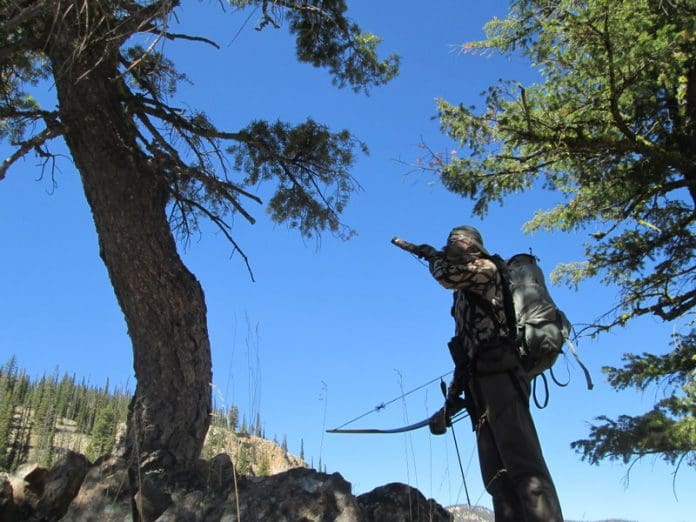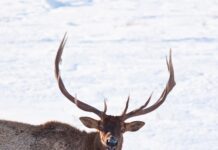Idaho OTC Elk, Part II: Tips on Finding Elk
By Ron Wright, Rokslide Member
In Part I, I talked about quality, licensing, and expectations (you can read that article here). So let’s now assume you have struck out in the points game in other states and are now planning a hunt in Idaho to fall back on. Maybe you even just skipped the points game all together and want to get some experience under your belt before you start spending those expensive points all over the West. In this article, I’m going to take the info to the next level with a real world example on finding elk in an OTC zone I had never set foot in.
There are a lot of great articles across the internet written by better elk hunters than I am, so I’m not going to go into too many details on hunting elk. I’m focusing on experiences drawn from my first time into new areas after the map research. I think this will be a little more relative to what you will encounter. If you’re coming from another state, you’re most likely going to be doing all your scouting on maps and Google Earth and then going into the area for the first time during your hunt or maybe a couple days before. This is good. Just study the maps until you have them memorized and go for it. Ultimately, time in the field is the best teacher, so don’t stress out too much in the beginning, just get out there and start learning.
Scouting from home; the first step
As you pass time in the off season on Google Earth and topo maps, here are some potential map features to look for:
● An off trail hike up the side of a mountain with at least a 1000 foot elevation gain, usually more. Nothing is too steep for an elk.
● Long main ridge that gains about 3000 feet of elevation from the low end to the high end. The low end will typically terminate into a bigger creek or river and the high end (in Idaho) will be good Mountain Goat habitat.
● A recent burn or a high country meadow with adjacent dark timber.
● The topographic symbol on USGS maps for a marsh might as well be a symbol for feeding elk. They prefer the highest ones which give them the biggest buffer between them and the rest of the world.
● A bench on a steep slope is a great feeding and bedding location.
● The upper third of a steep thickly timbered north slope is a good bedding location and feeding location in hot dry weather.
● The headwaters of a creek or stream. There can be a wallow near where it trickles out of the ground. Elk and especially bulls are almost always near water during the September rut hunts.
On the ground
It typically takes me the good part of a day to get up into the better elk areas. This includes driving to the take-off point and hiking in. If I’m hunting out of a road camp, I can usually be into decent elk country after about a two-to-four hour hike. If you’re hiking into roadless areas that hold elk, they seem to appear at about 3:00 to 4:00 in the afternoon and in the early morning. If I don’t find them the first night or second day, then I try a new spot.
When you find the elk, you are way ahead in the game if you can keep a lot of the elevation you have overcome. For me, spending the night up on top is the most efficient way to hunt some of these areas, especially in late summer/early fall. Making that elevation gain on a daily basis will wear you out quickly and wastes hunting time. When I have a choice, I would rather be setting up camp wherever I’m at when it gets dark versus hiking back to camp in the dark.
This is especially advantageous if I harvest the last hour of shooting light. Instead of worrying about getting safely back to camp or what to do with the meat, I can take my time processing the meat and let it hang in the cool night air. I can then start packing meat in the cool of the morning and probably be to a creek by the time the air starts to heat up. This is where backpack hunting and carrying camp on your back the majority of the time really shines. Even in areas I’m familiar with, I just can’t beat the flexibility and efficiency that this style of hunting offers for DIY-OTC hunts. Also I typically hunt extended weekends so time efficiency is more of a factor.
For me, a comfortable and warm sleep system, good food, and boots that fit are what makes or breaks this style of hunting. I am a lot more efficient, effective, and focused when I’m comfortable and not just trying to survive the whole time. Over time, I have transitioned from a focus on ultralight gear to more of a utility & safety focus. My pack is a little heavier, but I’m better prepared. Rokslide is a wealth of knowledge for tuning your gear, so do your research.
Base camps off the road and shorter three-mile-or-less day hunts are also very productive. Us locals do this frequently and with great success, but we are able to scout and usually know the areas well. Once you learn a couple areas you will be able to hike in, make a play, and then move on to fresh elk if need be. If it’s a big bull, you can stay on him the whole time and pattern him. A nice base camp next to the vehicle starts to get real appealing as fall turns to winter. Also, as the snow in the high country gets deeper, the animals are forced lower and typically closer to roads and trails anyways. Either way, the main thing is to be efficient with your limited time and stay within your limits.
A Real World Example
Here is an example of an area I found doing map research in 2014. The following is an account of my first scouting trip in early August of that year.
After a long trail hike of about eight miles or so, there is about a 1000 foot ascent off trail to the first bench. This is a good example of trading elevation gain for distance. The spots that are three or four miles in typically have a 2000 foot ascent and seem much more difficult than the longer walks with less elevation gain. This first bench is a great place for a camp, and now has a small fire ring I built during a latter goat hunt. The next bench is another 200 feet up, abruptly, and leads to the main part of the basin. This is where the elk lived. The surrounding ridges are mountain goat habitat, which is what I was really looking for and also found on this scouting trip. I knew there were elk in here shortly after leaving the trail.
At about 300 feet up and away from the hiking trail, there was a well used game trail. Elk maintain a trail way better than the Forest Service does. When you see trails like this and it starts to smell like the petting zoo, you quickly forget how steep it is and how far in you are. At this point if I was scouting for just elk, I would pull out of there and find a vantage point across the canyon that has a good view of this whole area.
A well used elk trail
The basin looked barren on the topo map, but in this particular case it wasn’t. This isn’t always the case though. In fact, the basin to the east looked similar on the the topo map, but didn’t hold elk or goats at that time. I think it was too small and too boxed in by cliffs for elk to like.
While sitting near those reddish rocks to the left that afternoon, I had a good view of the meadow and the side of the canyon that gets shade from the afternoon sun . The elk were bedded in the shady timber to the right down low. More often than not, elk bed and feed in about the same area during shooting light when they are not getting pressured in these more remote areas. I think they may travel down lower to the more riparian areas in the cover of darkness as evidenced by the heavily used trails I sometimes find. I really don’t know for sure and I’m usually asleep when they would be doing this.
Elk feeding in a remote basin
The cow with two calves in the picture were joined by the rest of the herd and a raghorn when the sun finally went down behind the mountain. The timber along the creek between the camping bench and that meadow was a mess of fresh dead fall and hard to get through. This is another feature elk like and something to look for while you’re on your hunt or scouting. Elk have an advantage over wolves and hunters when it comes to moving through “blow downs” and they know this.
Typical blow down. Cow elk love this stuff.
With just a short scouting trip, I knew exactly where to start my hunt if and when I return to the area. Spend a few seasons doing this, and you’ll have plenty of country to hunt efficiently once the opener rolls around. It will be time well spent and the experience will hook you for a lifetime.
You can ask Ron questions or discuss this article here



















